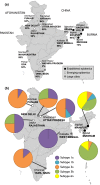Diversity of hepatitis C virus infection among HIV-infected people who inject drugs in India
- PMID: 31897414
- PMCID: PMC6917681
- DOI: 10.1007/s13337-019-00553-2
Diversity of hepatitis C virus infection among HIV-infected people who inject drugs in India
Abstract
The availability of generic direct acting antivirals (DAAs) for hepatitis C virus (HCV) treatment has prompted many low-and-middle-income countries to launch HCV elimination programs. Because the efficacy of some of these generic DAAs varies by HCV viral subtype, information on subtype distribution can contribute important information to these elimination programs. We conducted a cross-sectional serosurvey to characterize HCV subtype diversity among HIV positive people who inject drugs (PWID) across 14 cities in India. Of 801 HIV positive PWID sampled, 639 tested HCV antibody positive (78.9%). Among 105 samples sequenced, genotype 3 (58.1%) was the most commonly observed followed by genotype 1 (36.2%) and genotype 6 (5.7%). Of the genotype 3 infections, 65% were subtype 3a and 35% were subtype 3b. Of the genotype 1 infections, 94% were subtype 1a and 6% were subtype 1b. All genotype 6 samples were subtype 6n. There was some variability in genotype diversity depending on geographic region and PWID epidemic stage with greater diversity observed in older PWID epidemics. One sequence, HY018, did not cluster with any known reference sequences in phylogenetic analysis. Nearly 80% of HIV infected PWID across India are co-infected with HCV, and subtype prevalence and genetic diversity varied by region and PWID epidemic stage. HCV elimination programs in India will need to consider HCV subtype.
Keywords: Genotype; Hepatitis C virus; India; Low-and-middle-income country; People who inject drugs.
© Indian Virological Society 2019.
Conflict of interest statement
Conflict of interestThe authors have no conflicts of interest.
Figures
Similar articles
-
Treatment advocate tactics to expand access to antiviral therapy for HIV and viral hepatitis C in low- to high-income settings: making sure no one is left behind.J Int AIDS Soc. 2018 Apr;21 Suppl 2(Suppl Suppl 2):e25060. doi: 10.1002/jia2.25060. J Int AIDS Soc. 2018. PMID: 29633580 Free PMC article.
-
Respondent-driven sampling for identification of HIV- and HCV-infected people who inject drugs and men who have sex with men in India: A cross-sectional, community-based analysis.PLoS Med. 2017 Nov 28;14(11):e1002460. doi: 10.1371/journal.pmed.1002460. eCollection 2017 Nov. PLoS Med. 2017. PMID: 29182638 Free PMC article.
-
Natural prevalence of resistance-associated variants in hepatitis C virus NS5A in genotype 3a-infected people who inject drugs in Germany.J Clin Virol. 2015 Sep;70:43-45. doi: 10.1016/j.jcv.2015.07.008. Epub 2015 Jul 8. J Clin Virol. 2015. PMID: 26305818
-
Hepatitis C Reinfection in People Who Inject Drugs in Resource-Limited Countries: A Systematic Review and Analysis.Int J Environ Res Public Health. 2020 Jul 9;17(14):4951. doi: 10.3390/ijerph17144951. Int J Environ Res Public Health. 2020. PMID: 32659974 Free PMC article.
-
Is hepatitis C virus elimination possible among people living with HIV and what will it take to achieve it?J Int AIDS Soc. 2018 Apr;21 Suppl 2(Suppl Suppl 2):e25062. doi: 10.1002/jia2.25062. J Int AIDS Soc. 2018. PMID: 29633560 Free PMC article. Review.
Cited by
-
Network-based strategies to combat HCV: Examining social and spatial drivers of transmission among PWID in New Delhi.J Viral Hepat. 2024 Sep;31(9):535-543. doi: 10.1111/jvh.13960. Epub 2024 Jun 4. J Viral Hepat. 2024. PMID: 38837275
-
Direct-Acting Antiviral Treatment for Hepatitis C Genotypes Uncommon in High-Income Countries: A Dutch Nationwide Cohort Study.Open Forum Infect Dis. 2021 Jan 6;8(2):ofab006. doi: 10.1093/ofid/ofab006. eCollection 2021 Feb. Open Forum Infect Dis. 2021. PMID: 33614815 Free PMC article.
-
Role of direct and indirect social and spatial ties in the diffusion of HIV and HCV among people who inject drugs: a cross-sectional community-based network analysis in New Delhi, India.Elife. 2021 Aug 3;10:e69174. doi: 10.7554/eLife.69174. Elife. 2021. PMID: 34342266 Free PMC article.
-
Emergence of HCV genotype 6 and its new variants among intravenous drug users in Manipur, a north-eastern state of India.Ther Adv Infect Dis. 2025 Jul 13;12:20499361251351302. doi: 10.1177/20499361251351302. eCollection 2025 Jan-Dec. Ther Adv Infect Dis. 2025. PMID: 40661881 Free PMC article.
-
Hepatitis C virus genotypes among population with reported risk factors in Assam, north-east India: Emergence of genotype-8.Indian J Med Res. 2024 Jul;160(1):43-50. doi: 10.25259/ijmr_1222_23. Indian J Med Res. 2024. PMID: 39382494 Free PMC article.



